We drove 3 of the most popular minivans - and the winner was clear
And this big winner? It's the Pacifica!

The Pacifica's infotainment and audio/entertainment systems are the best of the bunch.
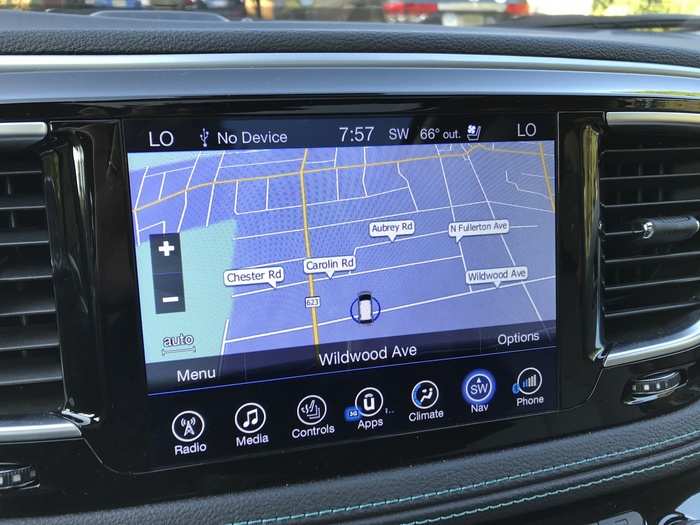
In my review, I wrote: "Chrysler's Uconnect is something of a sleeper in the world of auto tech. It's solid, but not showy. In our testing, it does an excellent job of getting the job done. The seven-inch screen could be larger, but it's far from alarmingly small."
Basically, Chrysler has taken it beyond the basics of Bluetooth connectivity and USB integration and delivered an up-to-date infotainment setup that's a good as what you'd find on a luxury SUV.
Neither Japanese carmaker has a minivan infotainment offering that's as current as what Chrysler has in the Pacifica. This might not be a deal breaker for minivan buyers, but these days, consumers are getting quite demanding when it comes to this stuff. Chrysler has this one covered.
Overall technology for the Pacifica is on par with the Odyssey and superior to the Sienna. A host of driver-assist features are also in the house, ranging from blindspot and cross-traffic warnings to front collision warnings, adaptive cruise control, lane-departure warnings, and many, many airbags.
The Pacifica is spacious and offers a more appealing interior than its competitors.
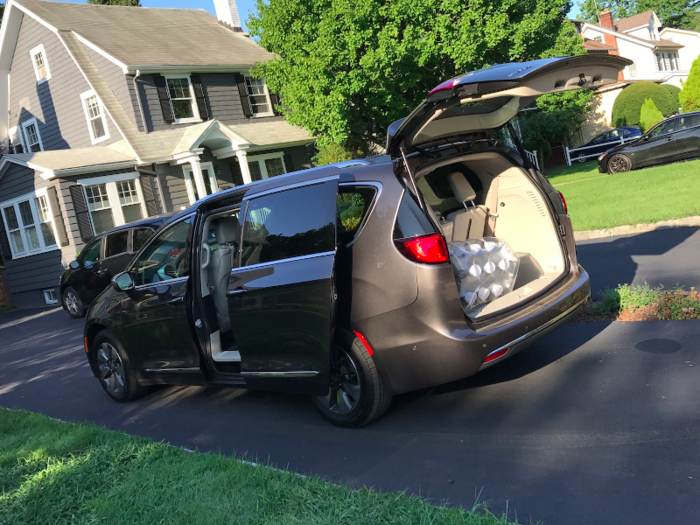
The Pacifica's interior is much nicer than either Odyssey's or the Sienna's. For what it's worth, I also think the exterior styling is far more suave and sophisticated.
But this is nothing new. The Town & Country that the Pacifica replaces had, to my eye, a nicer interior than the competition.
The Odyssey is the BMW of minivans. The Sienna is the Mercedes. But the Pacifica is the Cadillac.
Finally, we have the Chrysler Pacifica Hybrid.
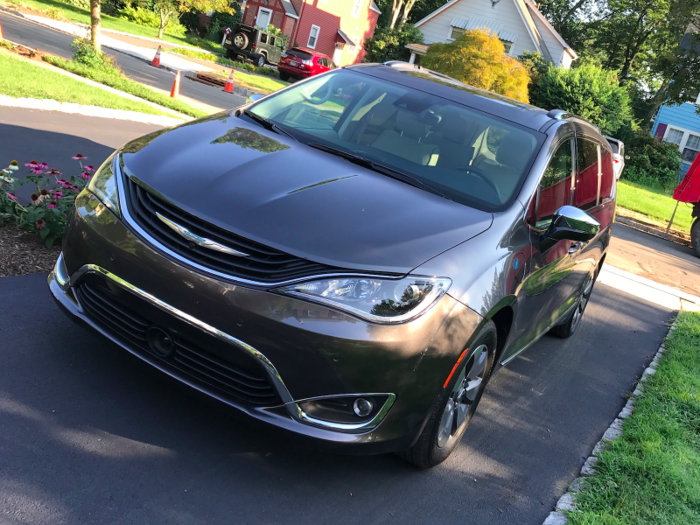
I will acknowledge up front that the 2018 Pacifica we tested came with the only plug-in hybrid drivetrain currently available for a minivan in the US, so the fight isn't entirely fair. But Chrysler is selling this option while Honda and Toyota aren't (and Toyota is the king of the hybrid hill), so I think the Pacifica is game.
Our tester was a $47,885 Hybrid Platinum trim level — about the same as the Odyssey we sampled, thousands more than the Sienna.
In my review, I wrote, "The Pacifica doesn't miss a trick, and the addition of the hybrid option, with a tasty 30-plus miles of all-EV range possible, means that for daily kid-transport duty, this machine could be a true money-saver."
I'm not going to say that the Pacifica is exhilarating to drive; it isn't. The 0-60 mph run consumes about 8 seconds, which is actually respectable considering the Pacifica weighs almost 5,000 pounds. The Pacifica is, however, fantastic at soaking up bumps and keeping road and wind noise to a minimum. Cruising at freeway velocities is a dream, and tooling around town is fine, although as with all minivans you have to aware of where the vehicle begins and ends to avoid minor bumps and scrapes.
Our tester had a 3.6-liter V6 yoked to a hybrid electric system whose two electric motors provide 260 total horsepower. Other Pacificas get a straight 3.6-liter V6, making more hp: 287. The hybrid has a CVT transmission, while the non-hybrid has a nine-speed automatic. On gas alone, the Pacifica's combined city/highway number is 32 mpg, while "MPGe" in 84, a consequence of being able to run the minivan on electric power alone for 33 miles, according to the carmaker.
The Sienna's infotainment system, like the Odyssey's, is good but not great. Unfortunately, it's less good than what we sampled in the Honda.
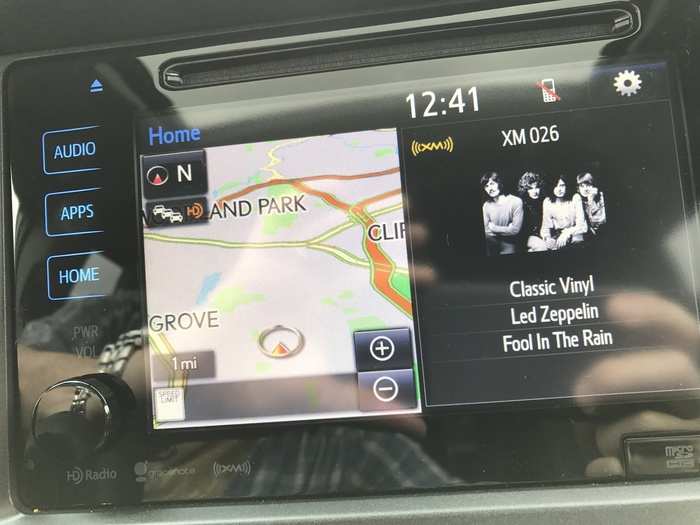
The infotainment and audio/entertainment systems in the Sienna are, to be perfectly honest, behind the times.
The navigation setup is fine, audio is adequate, and Bluetooth/USB connectivity is present. So all the boxes are checked off for the modern minivan enthusiast who wants and needs technology. But the Sienna has the worst infotainment offering of our three contenders.
Driver-assist features are more-or-less up to date, but backup cameras and blind-spot warnings have been relegated to "expected" by most new buyers, who want adaptive cruise control and more elaborate collision avoidance tech. Personally, I thought the Sienna was actually advantaged by the lack of bells and whistles: some of the newer tech is distracting and intrusive.
Toyota is well aware that it's squeezing the last days out of the Sienna's aging iteration, but actually using the vehicle for its intended purposes is a reminder that while newer is often better, it doesn't always radically redress the use case.
The bottom line is that is that if you buy the Sienna, you might find yourself gazing enviously at the Odyssey or Pacifica. But your minivan won't let you down in any major ways.
I did cram the Sienna with gear, and it brushed off the challenge.
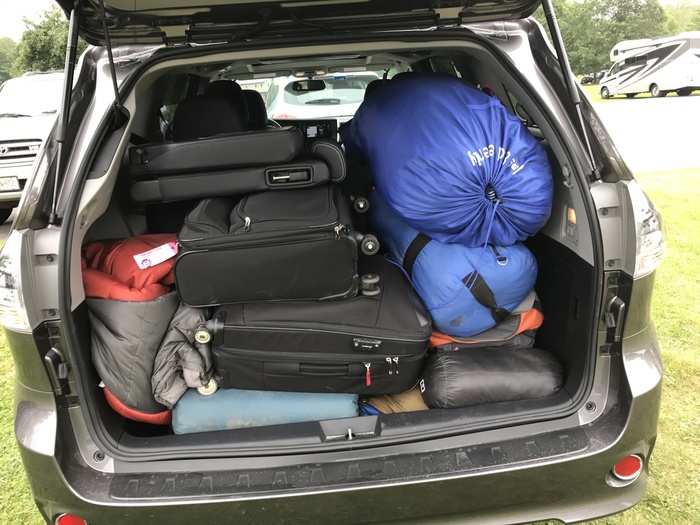
The Sienna is a little boring, but when push comes to shove — wow! This minivan was able to transport five kids and two weeks worth of their individual summer-camp gear with grace and dignity.
The Sienna is also roomy, versatile vehicle that easy to live with.
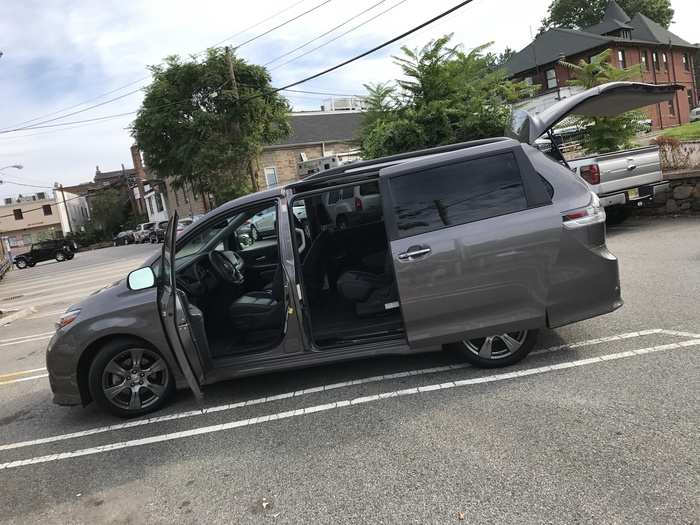
Wait, didn't I write exactly the same thing about the Odyssey?
Yes, I did. Our Sienna tester had power everything and plenty of space, as well as a comfortable interior that could be configured for up to eight occupants. Again, not edge to the other Japanese (yet entirely US-made) minivan in our contest.
However ...
On to the venerable Toyota Sienna.
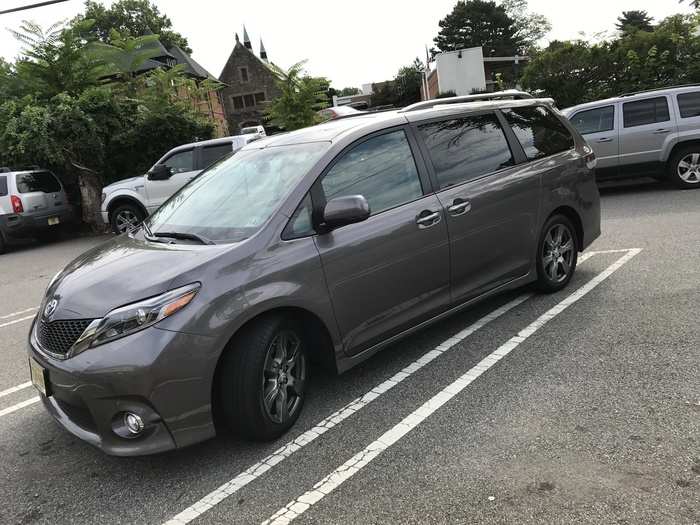
Toyota's minivan had more in store for it than Honda's. In my review, I noted that:
Over the course of a few days, I threw many challenges at the 2017 Sienna, a well-optioned, $41,700 SE Premium trim (the base model is about $30,000).
And I do mean many: a round-trip to pickup four kids from camp, plus all their equipment, as well as a jaunt to a lakefront hideaway with two kids and an extra adult. In between, I threw in some trips to Home Depot and the grocery store.
I was being a bit unfair to the Sienna, treating it like a workhorse while the Odyssey got off with less demanding suburban-dad duty.
The Sienna has a 3.5-liter V6 under the hood, and it's bulletproof. It cranks out an impressive 296 horsepower and enables the vehicle to accelerate from 0-60 in less than eight seconds, just what parents in need of freeway merging and passing power want.
This is one of the infrequently praised aspects of minivans: with curbs weights that can push 5,000 lbs., they need solid power. It's pretty easy to get the Sienna moving well north of the legal speed limit, something owners need to be mindful of — all that bulk soaks up any sense of velocity.
Fuel economy is fair: 19 mpg city/27 highway/22 combined, but in the same ballpark as the Honda. The Sienna is the only minivan in the US that can be had with all-wheel-drive, which takes those numbers down.
If the Odyssey is the BMW of minivans, the Sienna is the Mercedes. The Odyssey is sort of fun to drive, the Sienna isn't. It doesn't drive badly, but it is classic Toyota: soft, easygoing, quiet, undemanding. And the styling ... well, look at the picture. There isn't much.
Honda's infotainment and audio system is very good — but not great. Overall technology is excellent.
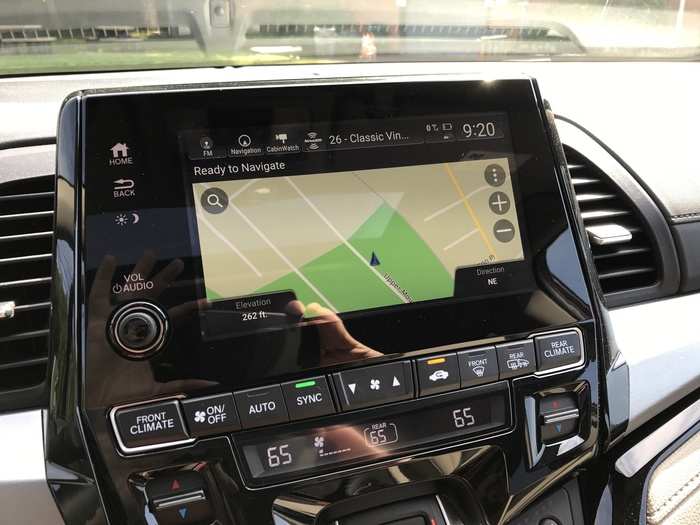
The infotainment setup was all I could find to complain about in the Odyssey. Both Honda and Toyota are lagging the industry on this front.
However, the Odyssey's system gets the job done and doesn't lack for anything consumers would expect, from Bluetooth connectivity to a second-row entertainment screen. Apple CarPlay and Android Auto are available, and you have plenty of places to plug in for USB connection and recharging.
Safety for the Odyssey is typically superb (our tester's model year hadn't yet been rated by the government), with airbags everywhere, and a suite of driver-assist features enhances the highway cruising aspect of the vehicle.
Bottom line is that the new Odyssey is as good as it ever was — but in a few places, it could be better. Our test vehicle did come with its own onboard vacuum, by the way, which counts toward extra credit.
The Odyssey is a roomy, versatile vehicle that easy to live with.
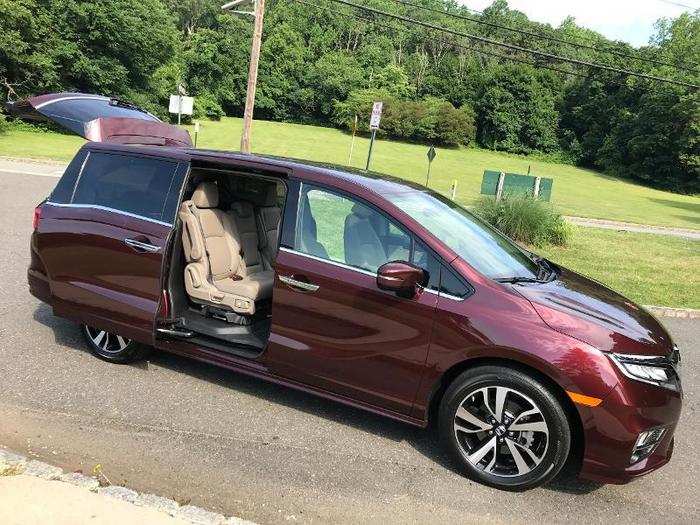
All three of our minivans under consideration checked off the relevant boxes for abundant space for seven or eight passengers and lots of gear. Like the Sienna and the Pacifica, the Odyssey that I tested came with power doors and a power liftgate, making getting in and out a breeze.
Just to cut to the chase, it wasn't possible to give any of the three minivans the edge in this department. Some consumers might want to compare cargo capacity, but in practical use, they're all in the same league.
The basic form of the minivan has been perfected at this stage of the same. Unless somebody builds a double-decker version and figures out a way to create TARDIS effect for the interior, that isn't going to change.
Yes, the specific operation of seats can vary, and in the case of the Odyssey, it was quite easy to configure everything so that access to the third row was easy. But that wasn't enough to tip things decisively in Honda's favor.
As for cupholders — there are many.
The mighty Honda Odyssey starts us off.
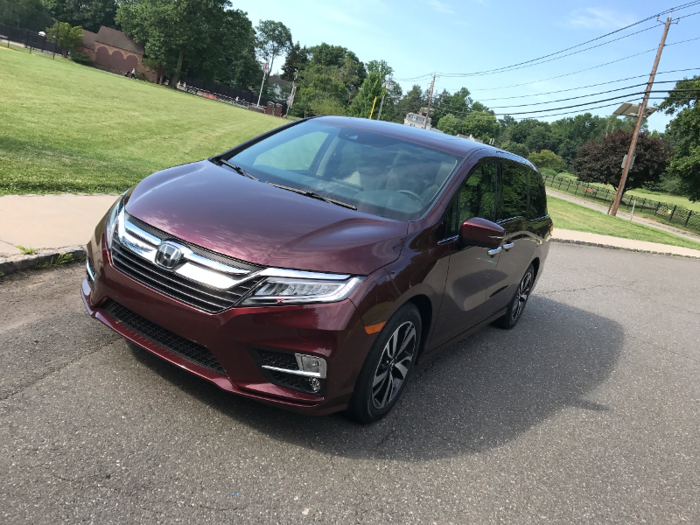
Here's what I wrote in my review of the jammed-packed-with-features $47,610 Elite trim-level test car that we sampled: "The versatility is unbeatable and always has been, and Honda has done great job of updating and upgrading a venerable platform. The latest generation is completely current as far as modern infotainment and connectivity go."
As a former Odyssey owner, I was primed for the 2018 edition of the vehicle — the fifth generation of a minivan that has won long-terms fans thanks to Honda's preoccupation with superb engineering. In minivan land, the Odyssey is the BMW of people-haulers.
The Odyssey is known as a "driver's minivan," and while I know that whole concept is preposterous, 0-60 mph in a shocking 6.6 seconds is nothing to sneeze at. The Odyssey's tasty 3.5-liter, 280-horsepower V6, one of the greatest engines available on any vehicle, provides confident merging and passing power, while the steering is responsive and the brakes do a good job of bringing the bulky car to a stop.
The styling has been toned down a bit from the previous generation, but the new Odyssey is still the most flamboyant minivan on the market.
All-wheel-drive isn't available, but a 10-speed transmission helps to deliver very decent EPA-rated fuel economy of 19 mpg city/28 highway/22 combined.
Popular Right Now
Popular Keywords
- India’s wearables market decline
- Vivo V40 Pro vs OnePlus 12R
- Nothing Phone (2a) Plus vs OnePlus Nord 4
- Upcoming smartphones launching in August
- Nothing Phone (2a) review
- Current Location in Google
- Hide Whatsapp Messages
- Phone is hacked or not
- Whatsapp Deleted Messages
- Download photos from Whatsapp
- Instagram Messages
- How to lock facebook profile
- Android 14
- Unfollowed on Instagram
Advertisement